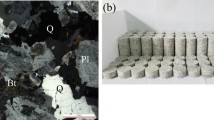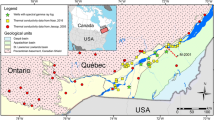Abstract
We present new measurements on the thermal properties of granitic rocks collected from a nearly 1000-m deep well in Central Portugal, using a transient plane source technique with a hot disk sensor. At room-temperature, the granite has, on average, a thermal conductivity of 3.1 W m−1 K−1, a thermal diffusivity of 1.6 × 10−6 m2 s−1, a heat capacity of 1.9 × 106 J m−3 K−1 and a specific heat of 720.7 J kg−1 K−1. A nearly uniform distribution of thermal conductivity values was obtained across the well. We found that as temperature increases from 20 to 120 °C, the thermal conductivity decreases from 9 to 16%. Linear, exponential, power and logarithmic functions were used to fit the dataset and their validity studied by error analyses. This made it possible to obtain empirical relationships to extrapolate thermal conductivity from room temperature to higher temperatures. The application of these relationships to our dataset leads to a decrease in thermal conductivity of 17 to 19% within the temperature range of 20 to 200 °C. These temperature corrections for thermal conductivity will be used in future studies to calculate geotherms and to assess the deep geothermal potential in central Portugal.
Resumen
Este trabajo presenta nuevas mediciones de las propiedades térmicas de rocas graníticas recolectadas en un pozo de aproximadamente 1000 m de profundidad en el centro de Portugal. Las mediciones se realizaron utilizando una técnica transitoria (transient plane source) con un sensor hot disk. A temperatura ambiente, las muestras graníticas tienen, en promedio, una conductividad térmica de 3.1 W m−1 K−1, una difusividad térmica de 1.6 × 10−6 m2 s−1, una capacidad de calor de 1.9 × 106 J m−3 K−1 y un calor específico de 720.7 J kg−1 K−1. En todo el pozo se obtuvo una distribución casi uniforme de los valores de conductividad térmica. Medidas de conductividad térmica en función de la temperatura, mostraron que a medida que la temperatura aumenta de 20 a 120 ºC, la conductividad térmica disminuye de 9 a 16%. Se utilizaron funciones lineales, exponenciales, potenciales y logarítmicas para ajustar el conjunto de datos y su validez estudiada por el análisis de errores. Esto posibilitó la obtención de relaciones empíricas para extrapolar la conductividad térmica de la temperatura ambiente a temperaturas más altas. La aplicación de estas relaciones a nuestro conjunto de datos conduce a una disminución de la conductividad térmica de 17 a 19% dentro de la gama de temperatura de 20 a 200 ºC. Estas correcciones de temperatura para la conductividad térmica serán utilizadas en estudios futuros para calcular el campo de temperatura en profundidad y para evaluar el potencial geotérmico profundo en el centro de Portugal.











Similar content being viewed by others
References
Abdulagatov, I. M., Emirov, S. N., Abdulagatova, Z. Z., & Askerov, S. Y. (2006). Effect of pressure and temperature on the thermal conductivity of rocks. Journal of Chemical and Engineering Data, 51(1), 22–33.
Adl-Zarrabi, B. (2006). Oskarsham site investigation—Borehole KLX12A: Thermal properties of rocks using calorimeter and TPS method. SKB Report P-06-72.
Amaral, P., Correia, A., Lopes, L., Rebola, P., Pinho, A., & Lopes, J. C. (2013). On the use of thermal properties for characterizing dimension stones. Key Engineering Materials, 548, 231–238.
Blázquez, C. S., Martín, A. F., Nieto, I. M., García, P. C., Pérez, L. S. S., & Aguilera, D. G. (2017). Thermal conductivity map of the Avila region (Spain) based on thermal conductivity measurements of different rock and soil samples. Geothermics, 65, 60–71.
Bohac, V., Gustavsson, M. K., Kubicar, L., & Gustafsson, S. E. (2000). Parameter estimations for measurements of thermal transport properties with hot disk thermal constants analyzer. Review of Scientific Instruments, 71(6), 2452–2455.
Chapman, D. S., & Furlong, K. P. (1992). Thermal state of continental lower crust. In D. M. Fountain, R. Arculus, & R. W. Kay (Eds.), continental lower crust (pp. 179–199). Amsterdam: Elsevier.
Chapman, D. S., Keho, T. H., Bauer, M. S., & Picard, M. D. (1984). Heat flow in the Uinta Basin determined from bottom hole temperature (BHT) data. Geophysics, 49(4), 453–466.
Clauser, C., & Huenges, E. (1995). Thermal conductivity of rocks and minerals. In T. J. Ahrens (Ed.), Rock physics and phase relations: A handbook of physical constants (pp. 105–126). Washington, DC: American Geophysical Union.
Eppelbaum, L., Kutasov, I., & Pilchin, A. (2014). Applied geothermics. Berlin: Springer.
Fernàndez, M., Marzán, I., Correia, A., & Ramalho, E. (1998). Heat flow, heat production, and lithospheric thermal regime in the Iberian Peninsula. Tectonophysics, 291, 29–53.
Ferreira, N., Iglesias, M., Noronha, F., Pereira, E., Ribeiro, A., & Ribeiro, M. L. (1987). Granitoides da Zona Centro Iberica e seu enquadramento geodinâmico. In F. Bea, A. Carnicero, J. C. Gonzalo, M. López Plaza, & M. D. Rodríguez Alonso (Eds.), Geologia de los granitóides y rocas associadas del Macizo Hesperico (pp. 37–51). Madrid: Editorial Rueda.
Fuchs, S., Förster, H.-J., Braune, K., & Förster, A. (2018). Calculation of thermal conductivity of low-porous, isotropic plutonic rocks of the crust at ambient conditions from modal mineralogy and porosity: A viable alternative for direct measurement? Journal of Geophysical Research: Solid Earth, 123, 1–13.
Gustafsson, S. E. (1991). Transient plane source techniques for thermal conductivity and thermal diffusivity measurements of solid materials. Review of Scientific Instruments, 62(3), 797–804.
Gustavsson, M., Karawacki, E., & Gustafsson, S. E. (1994). Thermal conductivity, thermal diffusivity, and specific heat of thin samples from transient measurements with hot disk sensors. Review of Scientific Instruments, 65(12), 3856–3859.
He, Y. (2005). Rapid thermal conductivity measurement with a hot disk sensor: Part 1. Theoretical considerations. Thermochimica Acta, 436, 122–129.
Hot Disk, A. B. (2007). TPS 2500 S. https://www.hotdiskinstruments.com/products-services/instruments/tps-2500-s/.
Jansson, R. (2004). Measurement of thermal properties at elevated temperatures—Brandforsk project 328-031. SP Report, 2004, 46.
Kim, S. K., & Lee, Y. (2017). Measurement of thermal properties of rocks at temperature up to 1000 °C with transient plane source techniques. American Geophysical Union, Fall Meeting 2017.
Lamas, R., Miranda, M. M., Pereira, A. J. S. C., Neves, L. J. P. F., Ferreira, N., & Rodrigues, N. V. (2017). 3-D distribution of the radioelements in the granitic rocks of Northern and Central Portugal and geothermal implications. Journal of Iberian Geology, 43, 3–12.
Lee, Y., & Deming, D. (1998). Evaluation of thermal conductivity temperature corrections applied in terrestrial heat flow studies. Journal of Geophysical Research, 103(B2), 2447–2454.
Lemenager, A., O’Neill, C., Zhang, S., & Evans, M. (2018). The effect of temperature-dependent thermal conductivity on the geothermal structure of the Sydney Basin. Geothermal Energy, 6(6), 1–27.
Maqsood, A., Gul, I. H., & Anis-ur-Rehman, M. (2004). Thermal transport properties of granites in the temperature range 253–333 K. Journal of Physics D: Applied Physics, 37, 1405–1409.
Merriman, J. D., Hofmeister, A. M., Roy, D. J., & Whittington, A. G. (2018). Temperature-dependent thermal transport properties of carbonate minerals and rocks. Geosphere, 14(4), 1961–1987.
Miao, S. Q., Li, H. P., & Chen, G. (2014). Temperature dependence of thermal diffusivity, specific heat capacity, and thermal conductivity for several types of rocks. Journal of Thermal Analysis and Calorimetry, 115, 1057–1063.
Miranda, M. M. (2014). Propriedades termofísicas em rochas graníticas: o caso da sondagem de Almeida (Guarda, Portugal Central). Master thesis, University of Coimbra, Portugal.
Miranda, M. M., Lamas, R., Pereira, A. J. S. C., Ferreira, N., & Neves, L. J. P. F. (2015a). Potencial térmico das rochas granitóides aflorantes na Zona Centro-Ibérica (Portugal). Comunicações Geológicas, 102(Especial 1), 133–136.
Miranda, M. M., Pereira, A. J. S. C., Costa, J. J., Rodrigues, N. V., & Matos, C. R. (2015a). Thermal properties of a Hercynian granitic rock: data from a deep borehole (Almeida, Central Portugal). Book of abstracts Energy for Sustainability 2015, Coimbra.
Ramazanova, A. E., & Emirov, S. N. (2012). Baric and temperature dependences for the thermal conductivity of sedimentary rocks. Bulletin of the Russian Academy of Sciences, Physics, 76(10), 1152–1156.
Sass, J. H., Lachenbruch, A. H., Moses, T. H., Jr., & Morgan, P. (1992). Heat flow from a scientific research well at Cajon Pass, California. Journal of Geophysical Research, 97(B4), 5017–5030.
Schatz, J. F., & Simmons, G. (1972). Thermal conductivity of earth materials at high temperatures. Journal of Geophysical Research, 77(35), 6966–6983.
Seipold, U. (1992). Depth dependence of thermal transport properties for typical crustal rocks. Physics of the Earth and Planetary Interiors, 69, 299–303.
Seipold, U. (1995). The variation of thermal transport properties in the Earth’s crust. Journal of Geodynamics, 20(2), 145–154.
Seipold, U. (1998). Temperature dependence of thermal transport properties of crystalline rocks—a general law. Tectonophysics, 291, 161–171.
Seipold, U., & Gutzeit, W. (1980). Measurements of the thermal properties of rocks under extreme conditions. Physics of the Earth and Planetary Interiors, 22, 272–276.
Seipold, U., & Huenges, E. (1998). Thermal properties of gneisses and amphibolites—high pressure and high temperature investigations of KTB-rock samples. Tectonophysics, 291, 173–178.
Somerton, W. H. (1992). Thermal properties and temperature-related behaviour of rock/fluid systems. New York: Elsevier.
Sundberg, J. (2002). Determination of thermal properties at Äspö HRL: comparison and evaluation of methods and methodologies for borehole KA 2599 G01. SKB Report R-02-27.
Sundberg, J., & Gabrielsson, A. (1999). Äspö Hard Rock Laboratory: Laboratory and field measurements of thermal properties of the rocks in the Prototype Repository at Äspö HRL. International Progress Report IPR-99-17.
Vosteen, H.-D., & Schellschmidt, R. (2003). Influence of temperature on thermal conductivity, thermal capacity and thermal diffusivity for different types of rocks. Physics and Chemistry of the Earth, 28, 499–509.
Zeb, A., Mehmood, S., & Maqsood, A. (2008). Modeling of effective thermal conductivity of dunite rocks as a function of temperature. International Journal of Thermophysics, 29(4), 1470–1479.
Zoth, G., & Hänel, R. (1988). 10 Appendix. In R. Haenel, L. Rybach, & L. Stegena (Eds.), Handbook of terrestrial heat-flow density determination (pp. 449–466). Dordrecht: Kluwer Academic Publishers.
Acknowledgements
This work has been framed under the Initiative Energy for Sustainability of the University of Coimbra and supported by the Energy and Mobility for Sustainable Regions Project (CENTRO/07-0224-FEDER-002004), co-funded by the European Regional Development Fund (ERDF) through the « Programa Operacional Regional do Centro 2007–2013 (PORC) » , in the framework of the « Sistema de Apoio a Entidades do Sistema Científico e Tecnológico Nacional » , and by the « Fundação para a Ciência e Tecnologia » . The authors would like to acknowledge Prof. José António Simões Cortez and Municipality of Almeida for allowing the study of the borehole core and Telma Matias for the technical support during thermal properties measurements. The authors are grateful to the anonymous reviewers for providing constructive suggestions that helped in improvement this manuscript.
Author information
Authors and Affiliations
Corresponding author
Rights and permissions
About this article
Cite this article
Miranda, M.M., Matos, C.R., Rodrigues, N.V. et al. Effect of temperature on the thermal conductivity of a granite with high heat production from Central Portugal. J Iber Geol 45, 147–161 (2019). https://doi.org/10.1007/s41513-018-0096-9
Received:
Accepted:
Published:
Issue Date:
DOI: https://doi.org/10.1007/s41513-018-0096-9




